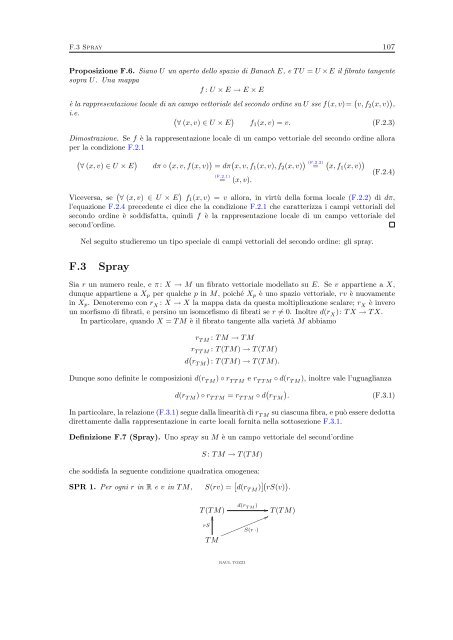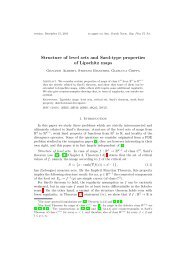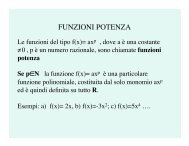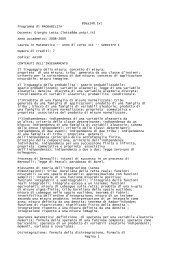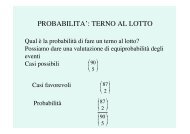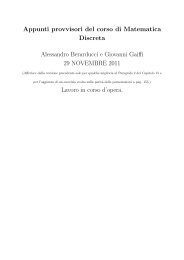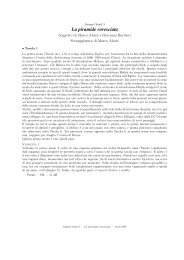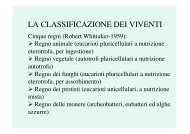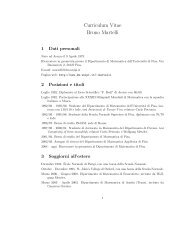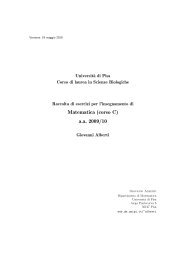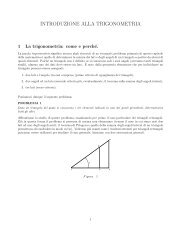Immersioni aperte in dimensione infinita - Dipartimento di Matematica
Immersioni aperte in dimensione infinita - Dipartimento di Matematica
Immersioni aperte in dimensione infinita - Dipartimento di Matematica
You also want an ePaper? Increase the reach of your titles
YUMPU automatically turns print PDFs into web optimized ePapers that Google loves.
F.3 Spray 107<br />
Proposizione F.6. Siano U un aperto dello spazio <strong>di</strong> Banach E, e T U = U ×E il fibrato tangente<br />
sopra U. Una mappa<br />
f : U × E → E × E<br />
è la rappresentazione locale <strong>di</strong> un campo vettoriale del secondo ord<strong>in</strong>e su U sse f(x, v)= v, f2(x, v) ,<br />
i.e.<br />
<br />
∀ (x, v) ∈ U × E f1(x, v) = v. (F.2.3)<br />
Dimostrazione. Se f è la rappresentazione locale <strong>di</strong> un campo vettoriale del secondo ord<strong>in</strong>e allora<br />
per la con<strong>di</strong>zione F.2.1<br />
∀ (x, v) ∈ U × E <br />
dπ ◦ x, v, f(x, v) = dπ x, v, f1(x, v), f2(x, v) (F.2.2)<br />
= x, f1(x, v) <br />
(F.2.1)<br />
= (x, v).<br />
(F.2.4)<br />
Viceversa, se ∀ (x, v) ∈ U × E f1(x, v) = v allora, <strong>in</strong> virtù della forma locale (F.2.2) <strong>di</strong> dπ,<br />
l’equazione F.2.4 precedente ci <strong>di</strong>ce che la con<strong>di</strong>zione F.2.1 che caratterizza i campi vettoriali del<br />
secondo ord<strong>in</strong>e è sod<strong>di</strong>sfatta, qu<strong>in</strong><strong>di</strong> f è la rappresentazione locale <strong>di</strong> un campo vettoriale del<br />
second’ord<strong>in</strong>e.<br />
Nel seguito stu<strong>di</strong>eremo un tipo speciale <strong>di</strong> campi vettoriali del secondo ord<strong>in</strong>e: gli spray.<br />
F.3 Spray<br />
Sia r un numero reale, e π : X → M un fibrato vettoriale modellato su E. Se v appartiene a X,<br />
dunque appartiene a Xp per qualche p <strong>in</strong> M, poiché Xp è uno spazio vettoriale, rv è nuovamente<br />
<strong>in</strong> Xp. Denoteremo con r X : X → X la mappa data da questa moltiplicazione scalare; r X è <strong>in</strong>vero<br />
un morfismo <strong>di</strong> fibrati, e pers<strong>in</strong>o un isomorfismo <strong>di</strong> fibrati se r = 0. Inoltre d(r X ): T X → T X.<br />
In particolare, quando X = T M è il fibrato tangente alla varietà M abbiamo<br />
r T M : T M → T M<br />
r T T M : T (T M) → T (T M)<br />
d <br />
rT M : T (T M) → T (T M).<br />
Dunque sono def<strong>in</strong>ite le composizioni d(r T M ) ◦ r T T M e r T T M ◦ d(r T M ), <strong>in</strong>oltre vale l’uguaglianza<br />
d(rT M ) ◦ rT T M = rT T M ◦ d <br />
rT M . (F.3.1)<br />
In particolare, la relazione (F.3.1) segue dalla l<strong>in</strong>earità <strong>di</strong> r T M su ciascuna fibra, e può essere dedotta<br />
<strong>di</strong>rettamente dalla rappresentazione <strong>in</strong> carte locali fornita nella sottosezione F.3.1.<br />
Def<strong>in</strong>izione F.7 (Spray). Uno spray su M è un campo vettoriale del second’ord<strong>in</strong>e<br />
S : T M → T (T M)<br />
che sod<strong>di</strong>sfa la seguente con<strong>di</strong>zione quadratica omogenea:<br />
SPR 1. Per ogni r <strong>in</strong> R e v <strong>in</strong> T M, S(rv) = d(r T M ) rS(v) .<br />
d(r T M )<br />
T (T M)<br />
<br />
T (T M)<br />
<br />
<br />
<br />
rS <br />
<br />
S(r ·)<br />
<br />
T M<br />
RAUL TOZZI


